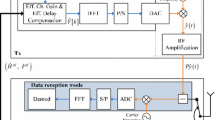Abstract
Rather than using existing self-interference cancellation methods, which essentially consist of reconstruction and subtraction, this paper proposes a novel approach, based on multiplication, to cancel selfinterference in the analog domain in full-duplex communications. This approach is called self-mixed selfinterference analog cancellation (SM-SIAC). Moreover, rather than using an individual analog cancellation circuit in existing self-interference cancellation methods, SM-SIAC can merge the analog cancellation circuit and the receiver. SM-SIAC is configured with three auto-tuning loops, consisting of one delay loop and two gain loops. SM-SIAC is further simplified with the Gaussian minimum shift keying (GMSK) self-interference signal. When these loops converge, the paper analyzes the cancellation capacity and derives a closed-form expression for the quadrature amplitude modulation self-interference signal and the GMSK self-interference signal. Simulation results illustrate the convergence of the gain loops and the cancellation capacity in the presence of engineering errors.
Similar content being viewed by others
References
Choi J I, Jain M, Srinivasan K, et al. Achieving single channel, full duplex wireless communication. In: Proceedings of 16th Annual International Conference on Mobile Computing and Networking (MOBICOM’10), New York, 2010. 1–12
Yin W S, Ren P Y, Li F, et al. Joint sensing and transmission for AF relay assisted PU transmission in cognitive radio networks. IEEE J Sel Areas Commun, 2013, 31: 2249–2261
Chen S, Beach M A, McGeehan J P. Division-free duplex for wireless applications. Electron Lett, 2002, 34: 147–148
Sahai A, Patel G, Sabharwal A. Pushing the Limits of Full-Duplex: design and Real-Time Implementation. Rice University Technical Report Networking and Internet Architecture (cs.NI). 2011
Duarte M, Sabharwal A. Full-duplex wireless communications using off-the-shelf radios: feasibility and first results. In: Proceedings of 44th Asilomar Conference on Signals, Systems and Computers (ASILOMAR), Pacific Grove, 2010. 1558–1562
Duarte M, Dick C, Sabharwal A. Experiment-driven characterization of full-duplex wireless systems. IEEE Trans Wirel Commun, 2012, 11: 4296–4307
Ahmed E, Eltawil A M, Sabharwal A. Rate gain region and design tradeoffs for full-duplex wireless communications. IEEE Trans Wirel Commun, 2013, 12: 3556–3565
Zhan Z, Villemaud G, Gorce J M. Design and evaluation of a wideband full-duplex OFDM system based on AASIC. In: Proceedings of IEEE 24th International Symposium on Personal Indoor and Mobile Radio Communications (PIMRC), London, 2013. 68–72
Duarte M, Sabharwal A, Aggarwal V, et al. Design and characterization of a full-duplex multiantenna system for WiFi networks. IEEE Trans Veh Technol, 2014, 63: 1160–1177
Jain M, Choi J I, Kim T, et al. Practical, real-time, full duplex wireless. In: Proceedings of 17th Annual International Conference on Mobile Computing and Networking (MOBICOM’11), New York, 2011. 301–312
Bharadia D, Mcmilin E, Katti S. Full duplex radios. In: Proceedings of ACM SIGCOMM 2013 Conference (SIGCOMM’ 13), New York, 2013. 375–386
Bharadia D, Katti S. Full duplex MIMO radios. In: Proceedings of 11th USENIX Symposium on Networked Systems Design and Implementation (NSDI’14), Seattle, 2014. 359–372
Radunovic B, Gunawardena D, Key P, et al. Rethinking indoor wireless mesh design: low power, low frequency, full-duplex. In: Proceedings of IEEE Workshop on Wireless Mesh Networks (WIMESH 2010), Boston, 2010. 1–6
Hong S S, Mehlman J, Katti S. Picasso: flexible RF and spectrum slicing. In: Proceedings of ACM SIGCOMM Computer Communication Review—Special October Issue (SIGCOMM’12), New York, 2012. 37–48
Hong S, Mehlman J, Katti S. Picasso: full duplex signal shaping to exploit fragmented spectrum. In: Proceedings of 10th ACM Workshop on Hot Topics in Networks, New York, 2011. 16
McMichael J G, Kolodziej K E. Optimal tuning of analog self-interference cancellers for full-duplex wireless communication. In: Proceedings of 50th Annual Allerton Conference on Communication, Control, and Computing (Allerton), Monticello, 2012. 246–251
Choi Y S, Mehr H S. Simultaneous transmission and reception: algorithm, design and system level performance. IEEE Trans Wirel Commun, 2013, 12: 5992–6010
Meerasri P, Uthansakul P, Uthansakul M. Self-interference cancellation-based mutual-coupling model for full-duplex single-channel MIMO systems. Int J Antennas Propag, 2014, 2014: 405487
Hua Y B, Liang P, Ma Y M, et al. A method for broadband full-duplex MIMO radio. IEEE Signal Process Lett, 2012, 19: 793–796
Cheng W C, Zhang H L. Quality-of-service driven power allocations for wireless full-duplex bidirectional links. Sci China Inf Sci, 2014, 57: 042316
Intersil LLC. Active isolation enhancer and interference canceller QHx220. 2009. http://www.intersil.com/en/products /other-analog/noise-canceller/isolation-enhancer-noise-cancellation/QHX220.html
Abidi A A. Direct-conversion radio transceivers for digital communications. IEEE J Solid-State Circ, 1995, 30: 1399–1410
Razavi B. Design considerations for direct-conversion receivers. IEEE Trans Circ Syst II, 1997, 44: 428–435
Bardwell J. WiFi radio characteristics and the cost of WLAN implementation: a tutorial, comparing and contrasting the use of consumer-grade and commercial-grade equipment. Connect802 Corporation Technical Report. 2005
Li N, Zhu W H, Han H H. Digital interference cancellation in single channel, full duplex wireless communication. In: Proceedings of 8th International Conference on Wireless Communications, Networking and Mobile Computing (WiCOM), Shanghai, 2012. 1–4
Couch L W. Digital and Analog Communication Systems. New Jersey: Prentice-Hall, 1996. 495–496
Analog Devices. HMC346LC3B GaAs MMIC voltage-variable attenuator. http://www.analog.com/media/en/technicaldocumentation/data-sheets/hmc346lc3b.pdf
Susumu Inc. GL1L SOP thin film differential delay line. http://www.susumu-usa.com/pdf/products 40.pdf
Anaren Inc. Model XDL09-9-204 delay line. http://www.anaren.com/products/delay-lines
Murota K, Hirade K. GMSK modulation for digital mobile radio telephony. IEEE Trans Commun, 1981, 29: 1044–1050
Stüber G L. Principles of Mobile Communication. New York: Springer, 2012. 228–231
Author information
Authors and Affiliations
Corresponding author
Rights and permissions
About this article
Cite this article
Lu, H., Shao, S., Deng, K. et al. Self-mixed self-interference analog cancellation in full-duplex communications. Sci. China Inf. Sci. 59, 042303 (2016). https://doi.org/10.1007/s11432-015-5365-z
Received:
Accepted:
Published:
DOI: https://doi.org/10.1007/s11432-015-5365-z




